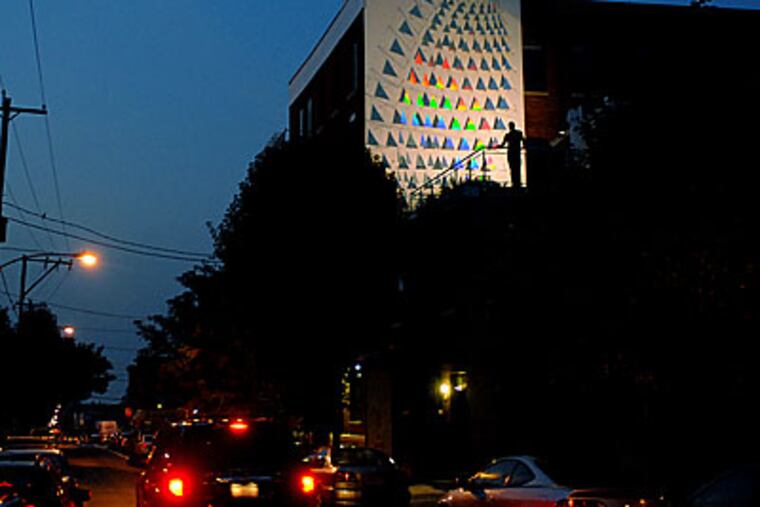Philly's light Fantastic
In Philadelphia, where most of the buildings are made from red brick and stone, we're used to surfaces that absorb the sun's light and keep it locked up tight. But the next time you find yourself walking up Third Street in Northern Liberties, be prepared to get drenched in a shower of reflected light.

In Philadelphia, where most of the buildings are made from red brick and stone, we're used to surfaces that absorb the sun's light and keep it locked up tight. But the next time you find yourself walking up Third Street in Northern Liberties, be prepared to get drenched in a shower of reflected light.
The colored downpour emanates from a contraption that looks like a government monitoring device but is actually the latest sculptural installation by artist Ray King. Protruding from the wall of his studio building, it resembles a radar dish that has been deconstructed into dozens of shimmering triangles. Aligned precisely with its southern meridian, the giant reflector is meant to help Philadelphians see their city, and its light, in a whole new way.
King calls the piece Hello David. It's his homage to 18th-century Philadelphia inventor David Rittenhouse, a fellow, King candidly admits, he never heard of until a few years ago.
The piece went up June 21, the day after the summer solstice, in honor of Rittenhouse's astronomical work. It's still a surprise to happen upon the fireworks of colored light along this stretch of Northern Liberties, just north of Fairmount Avenue.
We tend to associate such public art with the slick office towers of Center City, like the new Comcast Center. But King, whose installations light up university buildings, airports and public spaces around the world - as well as at Broad Street and Washington Avenue - felt his neighbors should be able to enjoy public sculpture closer to home.
"It's a gift to Northern Liberties," he explained. He hopes the piece, which faces south, will serve as a gateway to the neighborhood, home to many artists. "I think of it as a beacon. . . . It's a gracious, welcoming gesture."
King had been planning for years to install a glass sculpture on the side wall of his studio, housed in a former Ortlieb's brewery building. But it wasn't until he discovered Rittenhouse's work that he knew exactly what form the 600-pound piece would take.
King has always worked with colored glass, a legacy of his early training in stained glass. Over time he has realized that his true medium is light, and how we perceive it.
Rittenhouse, who was as famous in his day as his friend Ben Franklin, was interested in the same thing.
King was in Los Angeles, of all places, when he first heard about David Rittenhouse. He was visiting a supplier to purchase the special holographic film he uses to give his glass sculptures their sparkly, rainbow effect. The vendor struck up a conversation about Rittenhouse.
Who's that? King asked.
Why, the surprised salesman responded, Rittenhouse was a Philly guy, just like you, who was interested in light and its diffraction into the colors of the spectrum.
Intrigued, King did some research and learned that Rittenhouse was an astronomer, clock-maker, mathematician and surveyor. He may be best known for creating a mechanical model of the solar system, called an orrery. Rittenhouse was also fascinated with the way a beam of light could be broken down into a range of colors.
He devised several light-diffracting machines to study the phenomenon, but never got much credit for his efforts. His English contemporaries dismissed his experiments as irrelevant. But King is convinced the holographic paper he uses in his glass sculptures might never have been invented without Rittenhouse's early investigations.
The Los Angeles salesman who told King about Rittenhouse's light experiments also told him that the inventor had laid out Philadelphia's street grid. The salesman was wrong; Thomas Holmes did. But King liked the notion so much he decided to orient Hello David so it faces true south. The joke is that Philadelphia's north-south streets veer off in other directions.
King said he felt he had found his 18th-century soulmate in Rittenhouse. "It was like I had come full circle. He was one of many people in Philadelphia who did important things and made the city happen, and then was forgotten."
Well, not totally. But certainly many Philadelphians are only vaguely familiar with the accomplishments of a man whose name graces a prominent public square, a street, and any number of institutions. For them, Rittenhouse is just another of the city's ghosts, hanging around our street corners and calling out to us from doorways, while we obliviously go about our business.
Now Philadelphians have one more way of recalling Rittenhouse, every time they are showered with the light of King's sculpture.
For a slideshow of Ray King's works, including
Hello David, visit http://go.philly.com/sculptorEndText